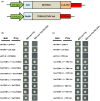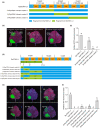TOM1 family conservation within the plant kingdom for tobacco mosaic virus accumulation
- PMID: 37443447
- PMCID: PMC10576174
- DOI: 10.1111/mpp.13375
TOM1 family conservation within the plant kingdom for tobacco mosaic virus accumulation
Abstract
The susceptibility factor TOBAMOVIRUS MULTIPLICATION 1 (TOM1) is required for efficient multiplication of tobacco mosaic virus (TMV). Although some phylogenetic and functional analyses of the TOM1 family members have been conducted, a comprehensive analysis of the TOM1 homologues based on phylogeny from the most ancient to the youngest representatives within the plant kingdom, analysis of support for tobamovirus accumulation and interaction with other host and viral proteins has not been reported. In this study, using Nicotiana benthamiana and TMV as a model system, we functionally characterized the TOM1 homologues from N. benthamiana and other plant species from different plant lineages. We modified a multiplex genome editing tool and generated a sextuple mutant in which TMV multiplication was dramatically inhibited. We showed that TOM1 homologues from N. benthamiana exhibited variable capacities to support TMV multiplication. Evolutionary analysis revealed that the TOM1 family is restricted to the plant kingdom and probably originated in the Chlorophyta division, suggesting an ancient origin of the TOM1 family. We found that the TOM1 family acquired the ability to promote TMV multiplication after the divergence of moss and spikemoss. Moreover, the capacity of TOM1 orthologues from different plant species to promote TMV multiplication and the interactions between TOM1 and TOM2A and between TOM1 and TMV-encoded replication proteins are highly conserved, suggesting a conserved nature of the TOM2A-TOM1-TMV Hel module in promoting TMV multiplication. Our study not only revealed a conserved nature of a gene module to promote tobamovirus multiplication, but also provides a valuable strategy for TMV-resistant crop development.
Keywords: ToMV; evolution; genome editing; host factor; resistance; tobacco mosaic virus.
© 2023 The Authors. Molecular Plant Pathology published by British Society for Plant Pathology and John Wiley & Sons Ltd.
Conflict of interest statement
The authors declare no conflict of interest.
Figures







Similar articles
-
Two TOBAMOVIRUS MULTIPLICATION 2A homologs in tobacco control asymptomatic response to tobacco mosaic virus.Plant Physiol. 2021 Dec 4;187(4):2674-2690. doi: 10.1093/plphys/kiab448. Plant Physiol. 2021. PMID: 34636879 Free PMC article.
-
Genome-wide analysis of tobacco NtTOM1/TOM3 gene family and identification of NtTOM1a/ NtTOM3a response to tobacco mosaic virus.BMC Plant Biol. 2024 Oct 10;24(1):942. doi: 10.1186/s12870-024-05632-1. BMC Plant Biol. 2024. PMID: 39385089 Free PMC article.
-
Editing of TOM1 gene in tobacco using CRISPR/Cas9 confers resistance to Tobacco mosaic virus.Mol Biol Rep. 2023 Jun;50(6):5165-5176. doi: 10.1007/s11033-023-08440-2. Epub 2023 Apr 29. Mol Biol Rep. 2023. PMID: 37119416
-
Quantifying Plant Viruses: Evolution from Bioassay to Infectivity Dilution Curves along the Model of Tobamoviruses.Viruses. 2024 Mar 12;16(3):440. doi: 10.3390/v16030440. Viruses. 2024. PMID: 38543805 Free PMC article. Review.
-
Getting Hold of the Tobamovirus Particle-Why and How? Purification Routes over Time and a New Customizable Approach.Viruses. 2024 May 30;16(6):884. doi: 10.3390/v16060884. Viruses. 2024. PMID: 38932176 Free PMC article. Review.
Cited by
-
Engineered Resistance to Tobamoviruses.Viruses. 2024 Jun 22;16(7):1007. doi: 10.3390/v16071007. Viruses. 2024. PMID: 39066170 Free PMC article. Review.
References
-
- Ali, M.E. , Ishii, Y. , Taniguchi, J.I. , Waliullah, S. , Kobayashi, K. , Yaeno, T. et al. (2018) Conferring virus resistance in tomato by independent RNA silencing of three tomato homologs of Arabidopsis TOM1 . Archives of Virology, 163, 1357–1362. - PubMed
-
- Asano, M. , Satoh, R. , Mochizuki, A. , Tsuda, S. , Yamanaka, T. , Nishiguchi, M. et al. (2005) Tobamovirus‐resistant tobacco generated by RNA interference directed against host genes. FEBS Letters, 579, 4479–4484. - PubMed
-
- Ding, X.S. , Liu, J. , Cheng, N.H. , Folimonov, A. , Hou, Y.M. , Bao, Y. et al. (2004) The tobacco mosaic virus 126‐kDa protein associated with virus replication and movement suppresses RNA silencing. Molecular Plant‐Microbe Interactions, 17, 583–592. - PubMed
Publication types
MeSH terms
Substances
LinkOut - more resources
Full Text Sources

